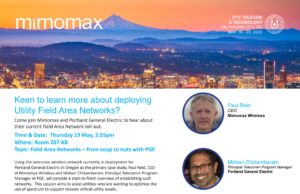Portland General Electric joins Mimomax to present at UTC TnT 2022
Mimomax customer, Portland General Electric (PGE) joined Mimomax on stage in Oklahoma City to present a session designed to assist other utilities with their planning for Field Area Network (FAN) deployments.
Key Steps
Mohan Chidambaram, Principal Telecomm Program Manager at PGE provided an overview of some of the key steps PGE took as they rolled out their Mimomax network:
1) Securing spectrum – Mohan noted the challenges faced by utilities in trying to gain access to spectrum. He suggested utilities work closely with a spectrum vendor.
2) Vendor Selection – many RFPs are run with the assistance of a consultant who will run the process at the stage where there are still multiple vendors bidding. The consultant may be involved in managing the RFP process, vetting vendors and running bench tests.
3) Gaining sponsor buy-in – Mohan stressed the need to “sell” the project internally otherwise projects of this scale may not get off the ground. He advised the importance of linking the FAN project to wider goals around ADMS and granular monitoring of the grid.
4) Building a Business Case for a FAN – the next step on from gaining the support of sponsors is to clearly articulate hard and soft cost-savings of deploying a FAN in addition to the benefits that will be gained and the penalties which will be avoided.
Narrowband vs Cellular
As part of this session, Mohan also outlined why PGE had chosen to use narrowband rather than cellular for their network. Their decision to choose a narrowband network was influenced by the following factors:
• Secure reliable network – repair, maintenance, downtime are in PGE’s control
• Security – FAN connects directly into PGE’s, rather than public, cellular network
• Durability – network will last as long as PGE wants it to last – cellular can sunset technology when business needs dictate it
• Capital vs. Opex
RF Network Design
Paul Reid, CEO at Mimomax, then provided a high-level overview of the network itself, outlining the service territory with 90-100 Tier 1 base stations and up to 6000 endpoints. He provided a summary of the RF design process Mimomax undertook including tips for modelling coverage percentages at various modulation rates and carrying out drive testing to calibrate the RF model.
The current capacity of the FAN allows support for multiple applications across any of the utility’s departments. The first applications which will use the new FAN are DA Reclosers, DER endstations and capacitor banks. Based on the current mix of devices that are likely to achieve connectivity through the FAN, PGE’s realistic predictions are that the FAN will be able to support 60,000-90,000 grid devices.
Lessons Learned
Mohan wrapped up the presentation with his list of Lessons Learned from the deployment to this point. According to Mohan, the technology is not the difficult part – the challenge is all about the process. He offered the following advice to assist with a more streamlined rollout:
1. Drawings – ensure you provide them in the right format and at the right time
2. Scheduling – careful scheduling of internal departments is required during the rollout
3. Permitting – local jurisdiction and local government compliance can slow things down
4. Expect that delays can occur due to things outside of your control – COVID & wildfires impacted PGE

